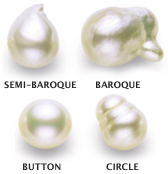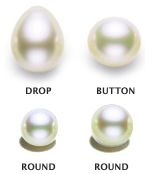

|
|
Long known as the "Queen of Gems," natural pearls were so rare and expensive that they were reserved almost exclusively for the noble and very rich. The creation of cultured pearls in the 1900s made it possible for many women to buy these beautiful spherical objects of beauty.
The value of the pearls in jewelry is determined by a combination of the luster, color, size, lack of surface flaw and symmetry that are appropriate for the type of pearl under consideration. Among those attributes, luster is the most important differentiator of pearl quality according to jewelers. All factors being equal, however, the larger the pearl the more valuable it is. Large perfectly round pearls are rare and highly valued. Teardrop-shaped pearls are often used in pendants. Irregular shaped pearls are often used in necklaces.
Pearls come in eight basic shapes, round, semi-round, button, drop, pear, oval, baroque, and ringed. Perfectly round pearls are the rarest and most expensive, and are generally used in necklaces, or strings of pearls. Semi-rounds are also used in necklaces or in pieces where the shape of the pearl can be disguised to look like it is a perfectly round pearl. Button pearls are like a slightly flattened round pearl and can also make a necklace, but are more often used in single pendants or earring where the back half of the pearl is covered, making it look like a larger, round pearl.
Drop and pear shaped pearls are sometimes refered to as teardrop pearls and are most often seen in earrings, pendants, or as a center pearl in a necklace. Baroque pearls have a different appeal to them than more standard shapes because they are often highly irregular and make unique and interesting shapes. They are also commonly seen in necklaces. Ringed pearls are characterized by concentric ridges, or rings, around the body of the pearl.
|
In general, cultivated or cultured pearls are less valuable than natural pearls, and imitation pearls are the least expensive. Although imitation pearls look the part, they do not have the same weight or smoothness as real pearls, and their luster will also dim greatly.
There is also a unique way of naming pearl necklaces. While most other necklaces are simply refered to by their physical measurement, strings of pearls have their own set of names that characterize the pearls based on where they hang when worn around the neck. A collar will sit directly against the throat and not hang down the neck at all, they are often made up of multiple strands of pearls. Pearl chokers nestle just at the base of the neck. The size called a princess comes down to or just below the collarbone. A matinee of pearls falls just above the breasts. An opera will be long enough to reach the breastbone or sternum of the wearer, and longer still, a pearl rope is any length that falls down further than an opera.
Necklaces can also be classified as uniform, where all the pearls are the same size, graduated, where the pearls are arranged in size from large in the centre to smaller at the ends, or tin cup, where pearls are generally the same size, but separated by lengths of chain. |